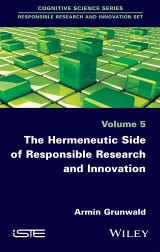Details

The Hermeneutic Side of Responsible Research and Innovation
1. Aufl.
|
139,99 € |
|
| Verlag: | Wiley |
| Format: | |
| Veröffentl.: | 22.11.2016 |
| ISBN/EAN: | 9781119340874 |
| Sprache: | englisch |
| Anzahl Seiten: | 240 |
DRM-geschütztes eBook, Sie benötigen z.B. Adobe Digital Editions und eine Adobe ID zum Lesen.
Beschreibungen
<p>The book investigates the meaning of RRI if little or no valid knowledge about consequences of innovation and technology is available. It proposes a hermeneutical turn to investigate narratives about possible futures with respect to their contemporary meaning instead of regarding them as anticipations of the future.</p>
<p>Foreword ix</p> <p>Preface xiii</p> <p><b>Chapter 1. What Makes New Science and Technology Meaningful to Society? 1</b></p> <p>1.1. Motivation and objectives 1</p> <p>1.2. The need for orientation in NEST fields 8</p> <p>1.3. Short propaedeutic 12</p> <p>1.3.1. The meaning of “sociotechnical meaning” 12</p> <p>1.3.2. NEST: new and emerging science and technologies 13</p> <p>1.3.3. Techno-visionary futures 15</p> <p>1.4. A brief guide to this book 17</p> <p>1.4.1. The flow of argumentation 17</p> <p>1.4.2. The chapters 18</p> <p>1.4.3. The achievements 22</p> <p><b>Chapter 2. Extending the Object of Responsibility Assessments in RRI 25</b></p> <p>2.1. Motivation and overview 25</p> <p>2.2. Some impressions of RRI debates so far 27</p> <p>2.3. A pragmatic view on the notion of responsibility 31</p> <p>2.3.1. The concept of responsibility 32</p> <p>2.3.2. The EEE approach to responsibility 34</p> <p>2.3.3. Responsibility assessment 35</p> <p>2.4. The object of responsibility debates in RRI so far 38</p> <p>2.5. The object of responsibility debates in RRI: an extension 39</p> <p>2.6. Concluding remarks 43</p> <p><b>Chapter 3. Assessing Responsibility by Considering Techno-Futures 45</b></p> <p>3.1. Responsibility assessments: introduction and overview 45</p> <p>3.2. Brief remarks on the epistemology of prospective knowledge 46</p> <p>3.2.1. The epistemologically precarious character of prospective knowledge 47</p> <p>3.2.2. Futures as social constructs 48</p> <p>3.3. Responsibility for NEST: the orientation dilemma 50</p> <p>3.3.1. Challenges to providing orientation in NEST fields 52</p> <p>3.3.2. The orientation dilemma 55</p> <p>3.4. Three modes of orientation 56</p> <p>3.4.1. Prediction and prognostication: mode 1 orientation 57</p> <p>3.4.2. Scenarios and the value of diversity: mode 2 orientation 58</p> <p>3.4.3. The value of divergence: mode 3 orientation 60</p> <p>3.5. The hermeneutic approach to techno-visionary futures 61</p> <p><b>Chapter 4. Definitions and Characterizations of NEST as Construction of Meaning 65</b></p> <p>4.1. Motivation and point of departure 65</p> <p>4.2. Some observations from NEST debates 66</p> <p>4.2.1. Nanotechnology 66</p> <p>4.2.2. Synthetic biology 68</p> <p>4.2.3. Enhancement 71</p> <p>4.3. The pragmatic character of definitions 72</p> <p>4.4. Defining and characterizing as meaning-giving activity 75</p> <p><b>Chapter 5. Understanding Nanotechnology: A Process Involving Contested Assignments of Meaning 79</b></p> <p>5.1. Nanotechnology: a paradigmatic RRI story 79</p> <p>5.2. The early time of nanotechnology: troubled beginnings 82</p> <p>5.2.1. Apocalyptic techno-visionary futures related to nano 82</p> <p>5.2.2. Threats to human health and the environment 84</p> <p>5.2.3. Philosophical characterizations 86</p> <p>5.3. Defining nanotechnology: a mission impossible? 89</p> <p>5.4. The meaning of nanotechnology: the shift from a revolutionary to a quite normal technology 94</p> <p>5.4.1. Looking back: the development of nanotechnology’s meaning 94</p> <p>5.4.2. Hermeneutic work on nanotechnology 96</p> <p>5.4.3. Lessons learned for RRI debates 99</p> <p><b>Chapter 6. Robots: Challenge to the Self-Understanding of Humans 101</b></p> <p>6.1. Autonomous technology: challenges to our comprehension 101</p> <p>6.2. Robots that can make plans and Man’s self-image 103</p> <p>6.2.1. Planning robots 103</p> <p>6.2.2. Planning as special type of acting 105</p> <p>6.2.3. Step 1: Can robots act? 107</p> <p>6.2.4. Step 2: What do robots do when they plan? 109</p> <p>6.2.5. The difference between planning humans and planning robots 113</p> <p>6.3. Technology futures in robotics 115</p> <p>6.4. The hermeneutic view of robots 119</p> <p><b>Chapter 7. Enhancement as a Cipher of the Future 123</b></p> <p>7.1. Introduction and overview 123</p> <p>7.2. On the semantics of (technical) enhancement 125</p> <p>7.2.1. Enhancement as action 125</p> <p>7.2.2. Technical enhancement 127</p> <p>7.3. Human enhancement 128</p> <p>7.3.1. Enhancement in history: some ambivalences 128</p> <p>7.3.2. Human enhancement: some illustrations 130</p> <p>7.3.3. Healing, doping and enhancement 132</p> <p>7.3.4. Human enhancement: from visions to the marketplace 136</p> <p>7.4. Animal enhancement 138</p> <p>7.5. Conclusions 142</p> <p>7.5.1. Conclusions I: dissolving borders between humans, animals and technology 142</p> <p>7.5.2. Conclusions II: better understanding contemporary time 144</p> <p>7.5.3. Conclusions III: technicalizing the self-image of humans 148</p> <p>7.5.4. Conclusions IV: RRI debates on enhancement 149</p> <p>7.6. Enhancement as a cipher of the future 151</p> <p><b>Chapter 8. Technology to Combat Climate Change: the Hermeneutic Dimension of Climate Engineering 153</b></p> <p>8.1. Climate change and the ambivalence of technology 153</p> <p>8.2. Limitations of the previous approaches to finding a solution 156</p> <p>8.3. Climate engineering as a technical option 157</p> <p>8.4. Chances and risks of climate engineering 159</p> <p>8.5. The hermeneutics of climate engineering 162</p> <p>8.5.1. Climate engineering: revival of Baconism? 163</p> <p>8.5.2. Expanding the object of responsibility 166</p> <p>8.6. Epilogue: hermeneutic extension of the imperative of responsibility? 168</p> <p><b>Chapter 9. Hermeneutic Assessment: Toward an Interdisciplinary Research Program 169</b></p> <p>9.1. Assigning meaning to NEST as object of responsibility 169</p> <p>9.2. Hermeneutic approaches 172</p> <p>9.3. The emergence of NEST meaning: hermeneutic assessment 175</p> <p>9.3.1. The dynamics of assigning meaning 175</p> <p>9.3.2. NEST meaning: understanding origin and process 178</p> <p>9.3.3. NEST meaning: understanding content 180</p> <p>9.3.4. NEST meaning: understanding diffusion and impact 183</p> <p>9.4. Reflection and epilogue 185</p> <p>Inspiration Behind the Chapters 189</p> <p>Bibliography 191</p> <p>Index 215</p>
<strong>Armin Grunwald</strong>, Professor of philosophy and ethics of technology at Karlsruhe Institute of Technology (KIT); Head of the Institute of Technology Assessment and Systems Analysis (ITAS) at KIT; Head of the Office of Technology Assessment at the German Parliament (TAB).

















